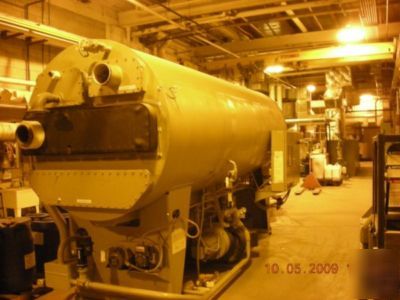Machine Parts For Reuse Newsgroup Discussion Forum > Large Size Parts
> New
> Mechanical
> Maiami
> Trane 294 ton absorption steam fired chiller
Trane 294 ton absorption steam fired chiller
Trane 294 Ton Absorption Steam Fired Chiller
This unit was used for 2 years in an experimental development application at General Electric. It was professionally installed and taken out of service. It was only used for a 2 year program. It has been out of service for the past 2 years.
This unit is in absolutely mint condition. It is like new come see it for your self. GE Paid $275,000.00 for this unit new.
Factory link to technical info
http:// /Commercial/Uploads/Pdf/1037/ABS-PRC005-EN_08012005.pdf
Cogen Waste Heat utilization
With the exception of very high cost electric areas, absorption chillers cost more to operate than electric chillers. They also cost about twice as much to purchase. Therefore, a reason other than average electric cost is needed to justify a base-loaded absorption system. Economics are more favorable for hybrid systems. Hybrid systems combine absorption chillers for use during on-peak electric hours and electric chillers for base load operation.
Steam-fired absorption is a good application where there is a low cost of steam such as a cogen or waste energy plant. Direct-fired natural gas units are used in hybrid and high-cost electricity areas. Absorption chillers do NOT use a CFC or HCFC refrigerant; therefore, some users purchase absorption chillers for this environmental advantage. Larger tonnages (above 500 tons) have a more favorable first cost when compared to electric technologies. Therefore, larger tonnage units are more common for absorption applications. They may also be used in places like campuses with a central steam loop and not enough electrical power distribution to run decentralize electric chillers. This may be the case where buildings either did not have chillers or used older single-effect absorption units and have upgraded to double-effect or direct fired absorption technology.
One of the oldest methods to mechanically cool a space is with absorption technology. It seems unreasonable to burn a flame to produce cooling, but that is what happens inside an absorption chiller.
The refrigerant used is actually water, as that is the working medium that experiences a phase change that causes the cooling affect. The second fluid that drives the process is a salt, generally lithium bromide. Heat is used to separate the two fluids; when they are brought back together in a near vacuum environment, the water experiences a phase change to remix with the salt at a very low temperature (at normal atmosphere pressure, water vaporizes at 212F; in an absorber, water vaporizes cold enough to produce 46F chilled water.)
Most manufacturers now offer units that are either steam or direct fired; earlier units were only steam fired. New units are also called "double effect", which gives them a much higher efficiency than the older units. The double effect is a second heat exchanger that boosts the efficiency from about 60% to near or just over 100% (100% is achieved when the existing space temperature is high enough to add some "free" heating energy to the process; since vapor compression is not used, it would otherwise be impossible to exceed 100% efficiency with known technology and lithium bromide.) (Third Effect absorbers are under development.)
View a PDF Document with more details on the refrigeration cycle.
An early problem was "crystallization" where something would go wrong in the cycle and the salt and water would permanently separate, and the salt would crystallize on the walls of the absorber. Modern controls pretty much make that impossible to happen now.
Absorbers are large units, with on-site assembly required, especially in the larger tonnage units. However, the direct-fired units with the ability to both heat and cool from the same unit can take up less space overall than a boiler and separate electric chiller. Some units can optionally heat and cool at the same time (for multi-zoned applications that have both a heated and chilled water loop).
Absorbers must have a cooling tower; air cooled units are not an option - even for the smaller units (except for Robur Units).
Absorbers use no CFCs or HCFCs.
Chilled water temperature is at its lowest at about 46F. Therefore, absorbers cannot be used in a low-temperature refrigeration application.
Absorbers have a COP that is about 1.0, compared to engine driven compressors about 1.5 and electric at about 3.0. However, if CFCs/HCFCs are an issue, or there is an already available source of steam (or "free" steam from a cogen or waste), an absorber could be the system of choice.
Absorbers with a COP of 1.0 burn 12,000 BTUs of gas for each ton-hour of cooling, or at $4.50 per MCF, $0.054/ton-hour. There is an electric load on the absorbers for pumps (in addition to cooling towers and chilled water loops) that must be considered as well.
An absorption chiller can break even with the cost of an electric chiller when the gas cost is below $4.50/MCF and the electric cost is above $0.08/KWH. Then you can deal with the additional first cost of the units, that will be at least 50% higher. Depending on the configuration of a direct-fired system, if a boiler cost is being offset and the tonnage is large enough, first cost may be closer in line with a separate gas boiler and electric chiller plant.
Steam-fired units require 50-125 psi steam and about 10 lbs/ton-hour steam usage. The higher the steam pressure, the lower the required pounds per ton usage.
Chiller Specifications Using Steam:
Tube Material: 95/05 CuNI.022 smooth
Tube Material: Cu ,. 028 smooth
http://www.energysolutionscenter.org/resources/PDFs/GT-SP05_absorption_cycle-an_asset_for_industry.pdf This is another great source of info.

